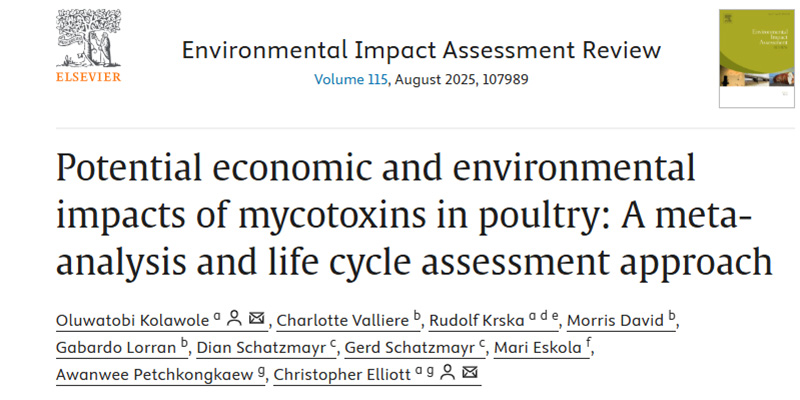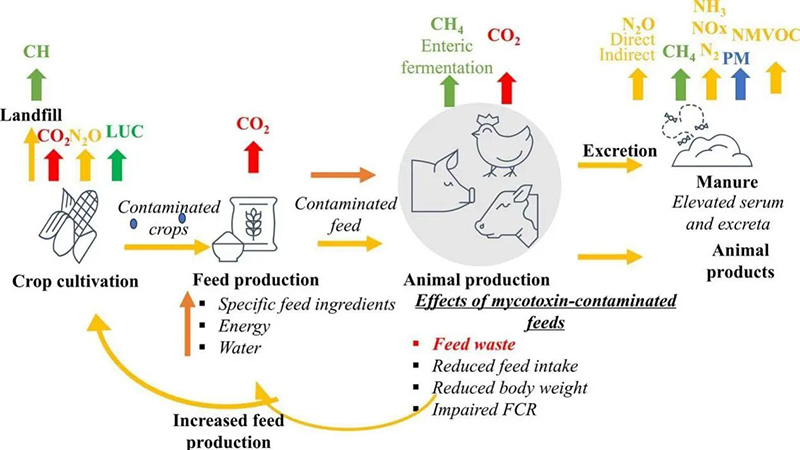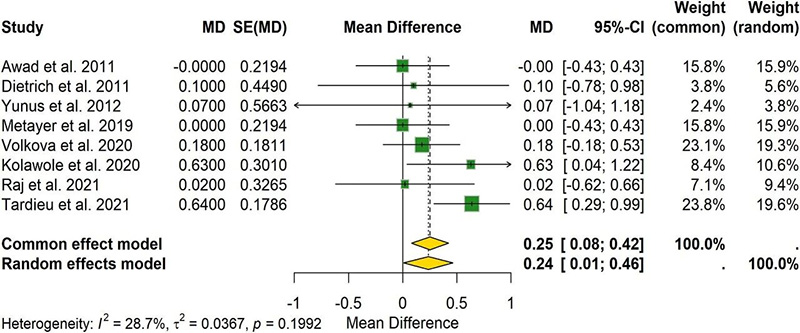
霉菌毒素是天然產生的有毒化合物,常見于污染動物飼料。雖然霉菌毒素對牲畜健康的影響已有廣泛研究,但量化其經濟與環境綜合影響的系統性研究仍顯不足。本研究通過整合薈萃分析與生命周期評價(LCA)方法,評估霉菌毒素污染飼料對肉雞生產造成的潛在經濟與環境后果——這一全球性問題。以歐洲比荷盧地區典型肉雞養殖場為模型,我們發現當禽類攝入兩種及以上受歐盟監管的霉菌毒素(脫氧雪腐鐮刀菌烯醇、玉米赤霉烯酮、伏馬毒素B1、赭曲霉毒素A及T-2/HT-2毒素)污染的飼料時,飼料利用效率顯著降低10.8%(p<0.05)。對于10萬只規模的養殖場,此類損失意味著每年需額外投入400噸飼料,成本增加約20萬歐元。為評估飼料霉菌污染的環境影響,研究分析了包括全球變暖潛勢、資源消耗、生態毒性、富營養化、酸化、臭氧層耗竭及電離輻射等19類環境足跡指標。LCA結果表明所有環境影響類別均呈加劇趨勢:因飼料增產及磷氮排泄增加,碳上升8.5%,全球變暖潛勢、酸化與富營養化影響顯著增強。本研究證實,解決小麥、玉米和大豆等飼料作物的霉菌毒素污染問題,對實現全球可持續、低碳且盈利的家禽養殖具有重要意義。
? 本研究結合薈萃分析與生命周期評價法,系統評估霉菌毒素對家禽養殖的經濟與環境影響。
? 霉菌毒素污染會降低飼料效率,導致生產成本上升與資源消耗增加。
? 生命周期評價顯示,因飼料效率下降,肉雞生產的碳增加8.5%。
? 霉菌毒素加劇氮磷排泄,進而強化富營養化與酸化效應。
? 研究結果強調需重新評估現行霉菌毒素限量標準,以減輕家禽養殖的經濟與環境負擔。

圖1.圖片摘要

圖2.肉雞生產系統“從搖籃到出欄”生存周期評估(LCA)的工藝流程和系統邊界。該圖概述了關鍵組成部分:肉雞系統的投入(飼料、添加劑和能量)、動物育種、肉雞生產(飼養、小型/大型操作、加工)和副產品管理(淘汰母雞、雞舍和糞便再利用或處理)。箭頭代表物質和能量在系統中的流動。

圖3.Meta分析和生存周期評價(LCA)在本研究中的整合示意圖。采用薈萃分析法量化霉菌毒素對肉雞生產性能的影響。這些性能的變化,然后被用來調整生存周期庫存(LCI)的輸入,包括飼料,肥料,水和排放數據。隨后,使用Sustell進行LCA建模?軟件模擬環境影響。最后的整合使受污染和未受污染的飼料系統能夠進行比較評價。

圖4.隨機效應模型森林圖,展示了飼喂自然受到多種霉菌毒素污染、且污染水平低于歐盟指導值的肉雞的飼料轉化率(FCR)。數據標記和黑色水平線分別代表每個研究以及相應的95%置信區間。每個綠色方框的大小與研究的權重成正比(即每個研究對整體效應大小的貢獻比(飼喂未受污染飼料的肉雞)相比,霉例)。黃色鉆石表示與對照組菌毒素對肉雞FCR的整體影響。結果顯示,飼喂受污染飼料的鳥類的FCR顯著增加(p=0.0456)。FCR值的增加通常表示飼料利用效率的降低。
Mycotoxins are naturally occurring toxic compounds that frequently contaminate animal feeds. While the effects of mycotoxins on livestock health are extensively studied, comprehensive research quantifying their combined economic and environmental impacts remains limited. This study addresses the research gap by integrating meta-analysis and life cycle assessment (LCA) to evaluate the potential economic and environmental consequences of broiler production using mycotoxin-contaminated feeds, a widespread issue globally. Using a representative broiler farm in the Benelux region of Europe as a model, we observed a 10.8 % reduction in feed utilization efficiency (p < 0.05) when birds consumed feeds contaminated with two or more EU-regulated mycotoxins (deoxynivalenol, zearalenone, fumonisin B1, ochratoxin A, and T-2/HT-2 toxin). For 100,000 birds, this inefficiency translated to 400 t of additional feed annually, costing around €200,000. In order to evaluate the environmental impacts of feed mycotoxin contamination, a comprehensive set of 19 environmental footprint categories was analyzed, including global warming potential, resource use, ecotoxicity, eutrophication, acidification, ozone depletion, and ionizing radiation. The LCA results revealed increased impacts across all categories, with an 8.5 % rise in carbon footprint and significant increases in global warming potential, acidification, and eutrophication due to heightened feed production as well as phosphorus and nitrogen excretion. This study shows that addressing mycotoxin contamination in feed crops such as wheat, maize, and soybean is important for achieving sustainable, low-carbon, and profitable poultry production globally.
This study combines meta-analysis and LCA to assess mycotoxins' economic and environmental impacts in poultry.
Mycotoxin contamination reduces feed efficiency, raising costs and resource use.
LCA shows an 8.5 % rise in broiler production's carbon footprint due to feed inefficiencies。
Mycotoxins increase nitrogen and phosphorus excretion, exacerbating eutrophication and acidification.
Findings highlight the need to re-evaluate current mycotoxin limits to reduce economic and environmental burdens in poultry production.